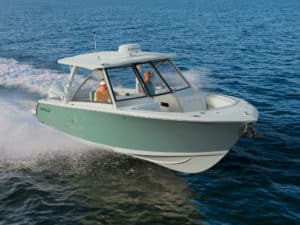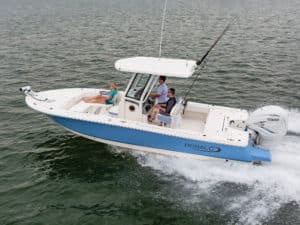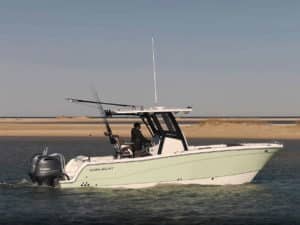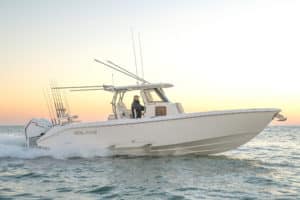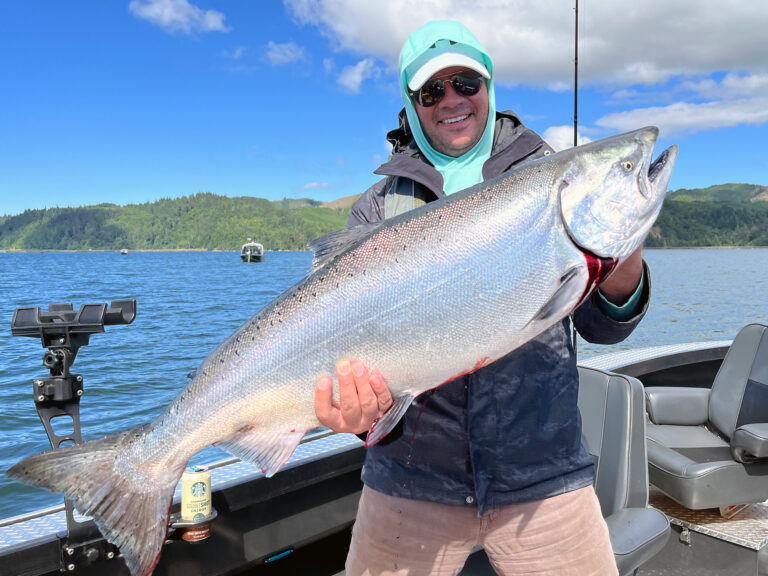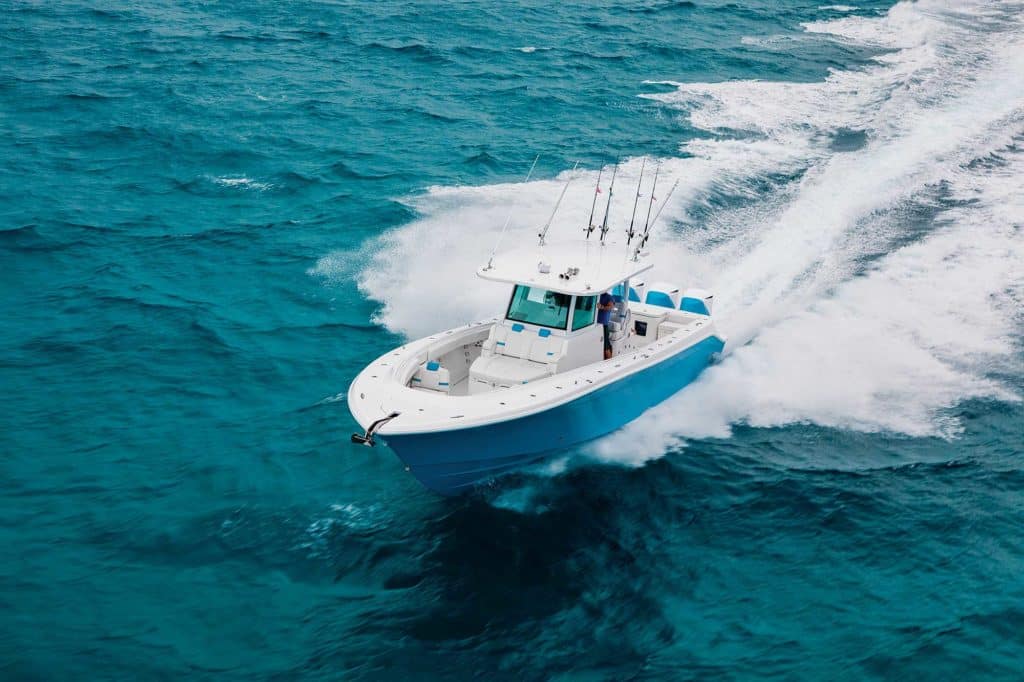
Power: Triple Yamaha F350s | Load: Three crew, 250 gal. fuel | Top Speed: 58 mph @ 6,000 rpm | Time to 30 mph: 9.5 sec. | Best MPG: 0.8 @ 46 mph (5,000 rpm) Hull
LOA: 38 ft. 11 in. | Beam: 11 ft. 6 in. | Transom Deadrise: 23 deg. | Dry Weight: 18,000 lb. (w/engines) | Draft: 24 in. | Fuel: 526 gal. | Max Power: 1,400 hp | MSRP: $749,840 (as tested) More Information: hcbyachts.com Courtesy HCB
The Florida Keys weather forecast called for scattered thundershowers and a 50 percent chance of rain on the May morning I fished HCB’s new center-console yacht — the 39 Speciale. But the weather service was a little off: Key Largo got deluged. It was the wettest day of offshore fishing I can ever recall. Dark storm cells hovered nearby, and while I heard thunder, I thankfully never saw lightning.
Given the conditions, we might have been overconfident. But the Speciale inspired that with its expansive hardtop, broad beam and solid feel. And, of course, it had the speed to outrun the storm cells that encircled us. You can do that pretty easily in an outboard center-console with 1,050 horsepower.
Outboard boats, in general, keep growing by leaps and bounds, but the demand for bigger center-consoles equipped to chase pelagics seems unstoppable. HCB aims to ride that swell, providing anglers with all the speed of performance outboards and all the comforts of a custom yacht. This boat was packed with evidence of that effort.
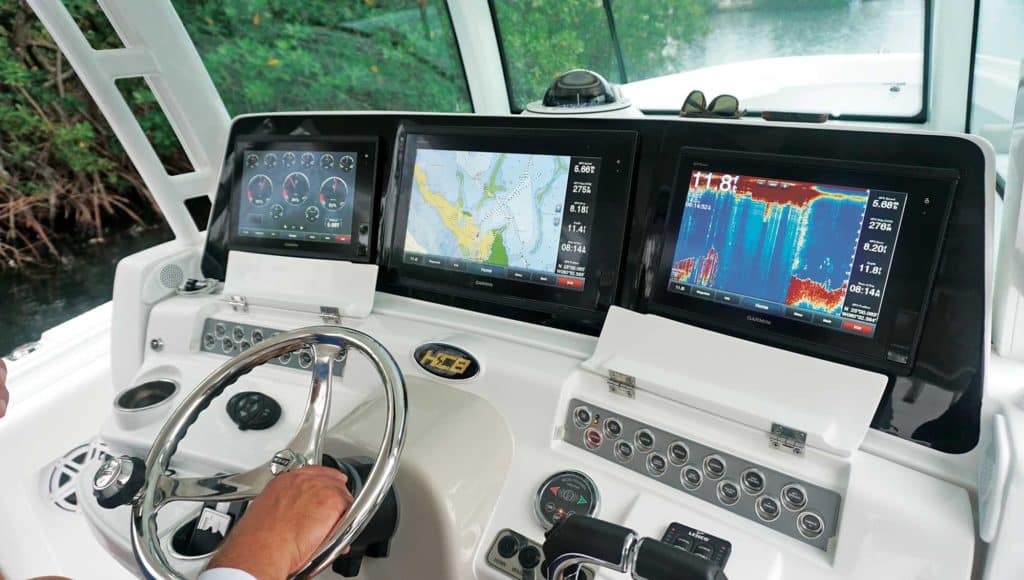
Comfort at Speed
On our damp day, burying the throttles brought us quickly to a top speed of 58 mph. The hole shot of the HCB was a thing of beauty. The 39 didn’t stand on its transom like a trained dolphin; it hugged the water, shooting forward with minimal bowrise. The triple Yamaha F350 white outboards offered their best fuel economy — 0.8 mpg — at 46 mph, turning 5,000 rpm.
To expedite our trip out to the Hump off Islamorada, our captain for the day, Gaby Pacheco, kept the 39 near that 50 mph mark. At speed, it was easy for two passengers plus Pacheco to duck behind the curved windshield to dodge the rain.
The 39’s wheel is centered, with the throttles mounted to the right, halfway between the starboard passenger and helmsman. The hardtop runs nearly to the gunwales on both sides, and a molded gutter drains any water aft of the console.
With the solid construction of a MilSpecs hull, the ride was also easy. HCB modeled its hull design from a military-approved standard. It employs stringers and crossbeams on 12-inch centers. The keel is laid with Kevlar, and the entire structure is as immovable as cast iron — until you apply the horsepower.
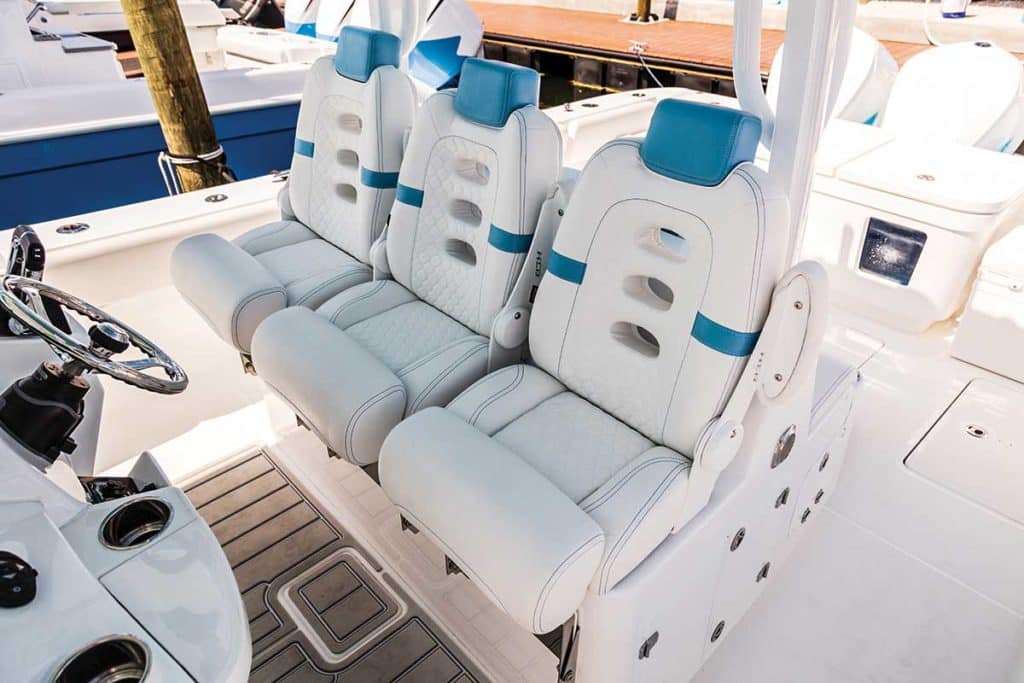
Triple bucket seats at the helm featured supple, leatherlike vinyl stretched taut over injection-molded foam, which holds its shape over time, hugging a body securely enough to diminish that feeling of sliding out in turns.
The helm face carried one 16-inch and two 12-inch Garmin electronics displays with integrated engine gauges and audio, plus chirp sonar. Even though all systems operated through the displays, HCB added two panels of switches for those who love button pushing more than touchscreen controls.
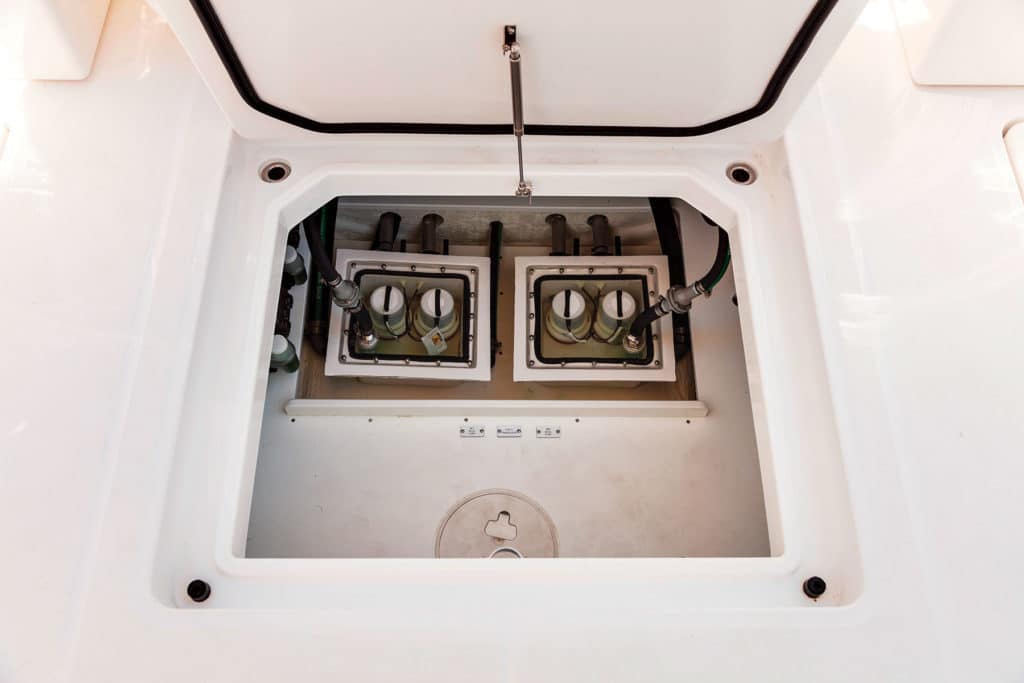
Fishworthy Features
Once at the Hump, we started rigging baits and setting lines. We took the building seas abeam. A nearby inboard sport-fishing boat wallowed in the seas, rocking its crew side to side, while the 39’s deck remained relatively level — one reason more anglers prefer the low center of gravity of outboard-powered boats.
Aft of the helm unit, a rear-facing lounge seats three. Contours in the injection-molded foam seat bottom keep passengers from sliding aft and out when the Speciale accelerates.
The neatest trick, though, was hidden beneath and behind the seat cushions. Our mate, Blythe Hofstetter, folded down the seat to reveal tackle-storage compartments and a rigging table. He tucked away the removable cutting board, replacing it with a utility tackle box that fit perfectly in the socket left by the board. Even more tackle storage is located below.
Our mate did plenty of rigging but didn’t need much tackle; we were dragging dead ballyhoo and also cutting them to chunk to the fish that followed our baits.
Even though HCB had not yet prepped the Taco Grand Slam outriggers aboard this test boat, we still put out an impressive spread of ’hoos, pulling one line at each gunwale and two in the shotgun rod holders.
HCB did its homework on designing the livewells, and it was a shame we didn’t get to use them. The pair of 40-gallon transom wells were pressurized, each fed by its own pair of pumps in their own sea chest. The livewell lids are clear plexiglass and gasketed, as expected. But to further restrict slosh and drool, a stainless-steel baffled vent diminishes water motion and drains any spillage aft into the livewell.
Watch Now: HCB 39 Speciale
Peanut mahi, not gaffers, were on the catch list that day, plus a wahoo with delusions of grandeur. The fish couldn’t have topped 7 pounds; it slipped through the gap of the gaff, releasing itself unharmed and dashing our hope for dinner.
Though all the fish we caught were small, I found a perfect place to fight them — in the port or starboard pockets between the livewells and the gunwales. I braced my feet between the two bulkheads and leaned my thighs comfortably against the bolstered transom.
A few of the larger schoolie dolphin found their way to one of a pair of fish boxes equipped with 12-volt cold plates, a handy system that eliminates the need to carry pounds of ice that might go unused.
Eager to raise better fish, we pulled the bait table out of its transom compartment and set it in a downrigger holder. Pacheco chopped some of our bait and used it for chum. If we’d had the ambition, the vertical holders could’ve sported downriggers, powered by a 12-volt outlet below.
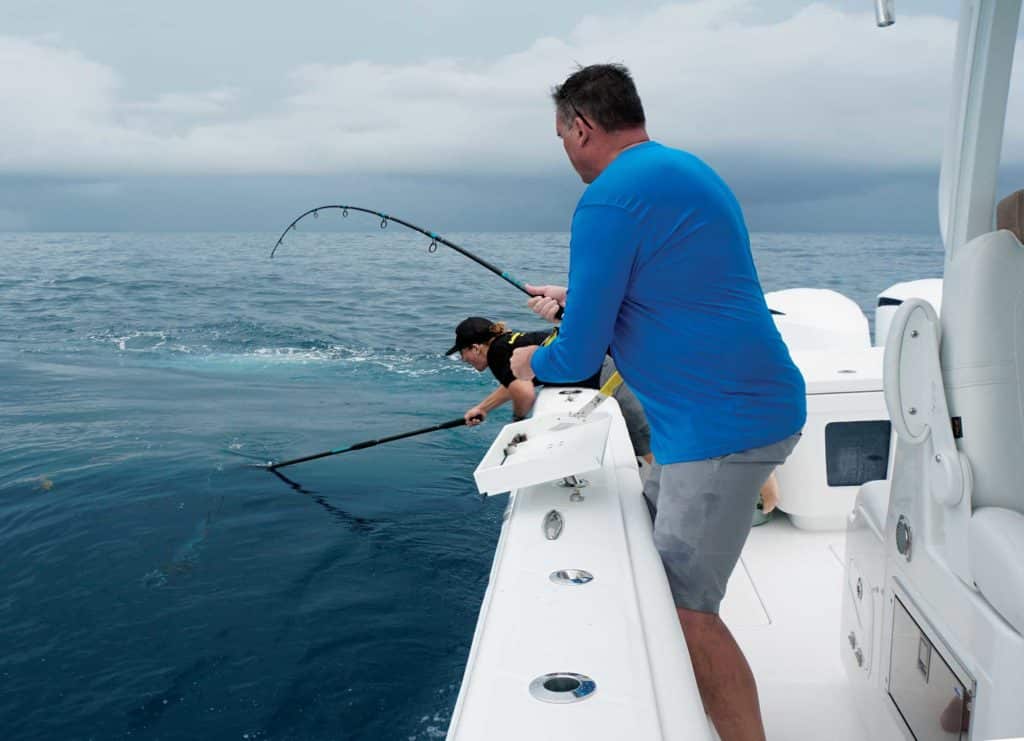
Clever Customization
I spent little time in the bow, but had it been sunnier, I might have stretched out on the center lounge. Beneath it is a 75-gallon compartment that can be used for gear, is plumbed for a cooler, or can be equipped with a cold plate to cool drinks or freeze fish.
Forward of that, optional lounges wrap around the bow with a removable cushion in the center for access to clear the windlass, should it be required.
I didn’t use the roomy cabin below the helm station either. It held a private head compartment at the bottom of the three-step ladder. Inside, in addition to the usual accouterments, were a removable tuna-rod rack and an LED lighted tackle cabinet stacked with large utility boxes. Both options come with the fishing package, which also includes the livewells. That system is built into a kind of “pod” that drops into the transom. Other options include a passenger bench.
I found a double berth belowdecks as well, making the private head all the more important. Some center-consoles position the berth directly adjacent to the head.
HCB uses the best hardware available to create its yacht finishes. From Gemlux fastenerless rod holders to removable fender hangers, fishing hardware is what one would expect on a luxury custom vessel. The gunwale door clicks shut like a premium-car door. Most builders also choose to design these side entries to open inward, but not everyone has figured out how to make the doors watertight, as has HCB with the 39 Speciale.
As in any luxury market, HCB customers can work with the company to further customize their vessels: Add a Seakeeper stabilizer or a genset, or put in a $50,000 stereo (companies do make those now). HCB will make the 39 Speciale any way you want it. That’s what custom yachts are all about.

